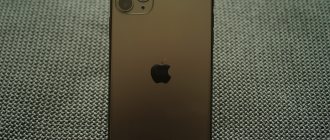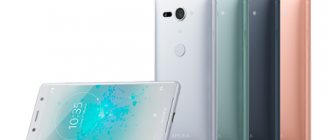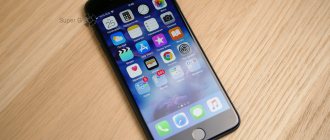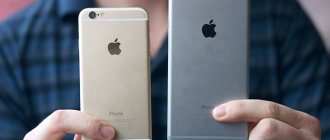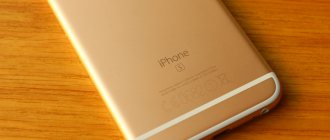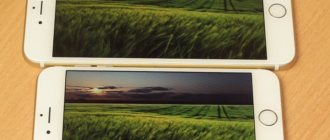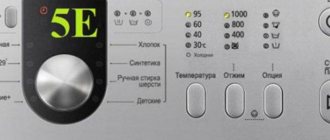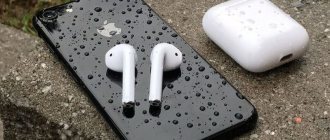The iPhone, one of Apple's most iconic products, has changed a lot this year. The one and only, special, original suddenly ceased to be so. Now there are two of them and you will have to choose which one to buy. The task, I will say right away, is not an easy one, and if you think that you will pick up both new products and immediately understand everything, I have to disappoint you - it’s difficult to decide. On the one hand there is an iPhone with ideal proportions, on the other there is an iPhone for ideal content consumption. Let's try to choose?
Buy an iPhone for 20 thousand cheaper than the market on DamProdam.ru. They change something and even give it away for free.
Before the full review, watch our short video of the iPhone 6 and iPhone 6 Plus - short and most important. Enjoy watching:
Design: iPhone 2G is alive!
The appearance of the last two generations of iPhone has become boring, to put it mildly. Yes, the iPhone 5s looks like a jewel with polished edges, but I’ve been wanting something new for a long time. And we know that the new is the well-forgotten old, which is why the iPhone 6 in your hands is so reminiscent of Apple’s first smartphone.
Rounded edges, a solid piece of aluminum and a comfortable fit in the hand. I’m talking now about both models - iPhone 6 and iPhone 6 Plus, since they are identical in design, the only differences are in size and in some hardware.
The new iPhone could be a real revelation for me, because I've always wanted a true smartphone of the future - a stylish, but no-frills slab of aluminum and glass. This is what the new product would look like if someone in Apple's design department had pulled Jony Ive's cue when he came up with the design of the antenna module in the iPhone 6. The lines you see on the back cover look mediocre. And using the example of thin and neat stripes on the back cover of the Taiwanese flagship HTC One M8, it’s even somehow sloppy and this is strange. Nevertheless, you can get used to this feature (controversial, by the way, this is a matter of taste).
After two days of use, the iPhone 6 already seems familiar. Eyes are already refusing to look at the 4-inch display, hands are reaching for the thin body and fingers want to run across the glass of the new smartphone again. Its edges are slightly rounded, so that the gadget looks and feels like a monolithic piece made of the right materials.
The only caveat is that it is slippery, so I recommend that you think about buying a cover in advance. It seems that Apple accessories are just the thing.
Other noticeable external changes include separate volume control buttons, which are now recessed into the body and can be pressed incredibly clearly. The Power button of the same shape has moved from the top edge to the right side. The thumb of the right hand or the index finger of the left hand rests directly on it. For the first few hours, of course, you continue to fumble around the top edge in search of a button, but over time everything falls into place - this is the only place where you can comfortably reach with your finger and lock/unlock the device.
Regarding the protruding camera module. He didn't bother me at all. Yes, it's noticeable, but the iPhone lies flat on the table and doesn't wobble when you press it on one side. Maybe there is still a minimal, almost imperceptible movement, but in normal use you don’t notice it. I tried to pry at the module with my fingernail, but nothing came of it.
Tim Cook's claims are somewhat exaggerated
The current head of Apple says that the company could have made an improved iPhone long ago, but wanted to “do it well.” In my opinion, they could have waited another year, because the new Apple phone is very annoying, and here I don’t mean the size, since trying to compress everything was unsuccessful. The problem is that when using a small portion of applications that are not adjusted for this screen size, I am forced to use the “zoom” mode.
Apple iPhone 6
Apple iPhone 6
Apple iPhone 6
Apple iPhone 6
I'm not going to judge the developers on this matter. The effect, however, is that as an iPhone 6 user I was disappointed in this regard. Fortunately, I, as a former iPhone 5s user, liked the device itself. Despite the fact that Androids with a similar screen surface are usually shorter, Apple has used several tricks that make working with a smartphone pleasant, but not as convenient as using the iPhone 5c.
Screens: Steve was wrong
iPhone 6 Plus, iPhone 6 and iPhone 5s
Immediately after the release of the iPhone 4 (3.5-inch screen), Steve Jobs commented at a press conference on the situation with smartphones equipped with large screens:
It is impossible to control them with your hands, no one will buy them. They're just like Hummer SUVs.
Four years later, his successor Tim Cook introduces two new SUVs. One with a large screen, the second with a huge one.
The screens of the new iPhones have been greatly increased in size compared to previous models. This is striking when you pick up the iPhone 6, and probably shocking when the iPhone 6 Plus falls like a shovel on your fingers. The awkward “hmmm-hmm” quickly changes into surprise - the quality of the display and pictures on them are a cut above those of the iPhone 5s.
The display displays colors perfectly, they are natural - not dull or violently burnt, as in Super Amoled screens, which Samsung is actively promoting in Galaxy smartphones. Viewing angles, I think, are the maximum possible. Just imagine that you turn your iPhone towards you, and the text on the screen remains perfectly readable. Yes, thanks to the new polarizer film in the iPhone 6/6 Plus, the display behaves much better in the sun than the iPhone 5s.
With the screen of the iPhone 6 Plus, the situation is exactly the same as with the iPhone 6. If you do not take into account that its dimensions will seem extremely large for the user of the “five”. The iPhone seems very unusual with such a screen and, it seems to me, that’s what Apple intended. This is practically a new device that can “eat up” some iPad mini users and launch the process, predicted by many, of turning iPad tablets into full-fledged computers with touch screens.
- iPhone 6: 4.7 inches, 1334×750 pixels
- iPhone 6 Plus: 5.5 inches, 1920x1080 pixels
Is a resolution of 1920 by 1080 pixels enough for a 5.5-inch screen? With your head. And don’t believe those who recommend urgently switching to QuadHD displays, which are already available in some Android smartphones - LG G3 and Samsung Galaxy Note 4. The human eye can only distinguish pixels at up to 300 ppi, while in the iPhone 6 Plus it is a whopping 401 pixels per inch. The performance race has never led to anything good. The iPhone compared to top Android gadgets is a prime example of this.
What else were expected in Cupertino at the opening?
Apple's new phone can be rated as the "best iPhone released so far", with some claiming it to be the best phone in the world. Even Apple's biggest fans have noted that in many ways Tim Cook's phones stand out from the competition.
I was very disappointed by the low battery capacity, lack of notification LED and stereo speakers. I would also like to have the phone waterproof in case of drowning. I also expected Apple to participate in the race called “wireless charging.” It upsets me that not all countries allow you to use the NFC module. Apple Pay will only work in the US and I won't be able to use the fast photo upload feature.
I still can't say for sure whether I'm happy with Apple's phone resizing.
I'm disappointed that Apple didn't release the iPhone 5s II, which would have included the A8, improved ISight webcam, NFC module and other components of the 6s in last year's case. I also don't think there will be an iPhone 6 Mini in the future.
The change in iPhone size marks the end of the era of small phones. I agree that 3.5 and 4 inch diagonal screen sizes were optimal for mobile phones a few years ago, but these are no longer sufficient.
The wealth of applications in the AppStore confirms that even Apple decided to sacrifice comfort in order to be able to use a large number of options at once.
Iron: simply better
It is not customary to talk about technical characteristics in the world of Apple mobile devices. Where have you heard users of different generations of iPhones talk about processors, RAM and, excuse me, overclocking? But you want this, right? Then here is a comparison of two smartphones in the Geekbench iOS application to calculate processor speed:
Yes, the iPhone 6 and iPhone 6 Plus are currently the most powerful smartphones Apple has ever created. They run on the same new generation Apple A8 processor with a clock speed of just (for the modern smartphone world) 1.4 GHz. Feel free to add the M8 coprocessor here, which helps you clearly count the number of steps taken and calories burned. RAM - 1 GB, same as in iPhone 5s. But was it ever not enough? This isn't a Mac.
What's the result? My overall impression is that iOS 8 runs slightly faster on the iPhone 6/6 Plus than on the iPhone 5s. The difference is very small, literally minimal, but it is there. This is traditional Apple magic, when you pick up a new iPhone, after which you no longer want to use the “old” one.
Yes, games load a moment faster, the multitasking menu with thumbnails appears in a second, but this is far from the main feature of the new iPhones. Oh yes, if you are confused by the operation of iOS on a 5.5-inch display with Full HD resolution, I will say that there are no problems. Both smartphones work almost identically, if you do not take into account minor slowdowns in literally a few games (Real Racing, this one is the most). This is an optimization question that developers need to ask. I played Asphalt 8, updated to work with direct access technology to GPU Metal, Modern Combat 5 and the graphics, I admit, were impressive.
It's a pity that Apple misses goals time after time
The good experience of using the iPhone is spoiled by the manufacturer itself. Not only does the iOS 8 update include a lot of bugs, but the update to iOS 8.0.1 turned out to be faulty. Although Apple released amendments two days later, numbered 8.0.2, the residue remained.
Even the most ardent fans should now stop laughing at Android and face the fact that Apple is a company like everyone else.
Not much can be said about the performance of the Cupertino hardware, except that these phones are very fast.
Everything loads quickly, efficiently and without unnecessary slowdowns. The new A8 dual-core system and 1GB of RAM are truly sufficient configuration for an Apple phone. I'm glad that at least the manufacturer is focused on optimizing the software, instead of adding new cores and gigabytes. The course has an impact on the ability to develop software for specific hardware configurations, but this simply shouldn't be of interest to the end user.
What's important to me as an Apple customer is that it just works. And for those who want to compare the iPhone 6 with its competitors, taking into account dry technical data, I will remind you again: this makes no sense, because the devil is in the software. The only interesting thing we can add is that the new M8 coprocessor actually calculates not only to count steps taken during the day, but also for history. Let everyone evaluate the usefulness of this information for themselves.
Battery: powerful, but lacking in innovation
I’ll be honest, it’s not easy to understand in two days how the batteries behave in new Apple smartphones. No, it's not even possible. I can say one thing for sure - my iPhone 5s, which I have been using for about 8 months, has held its charge several times worse during this time than both new items that were lying next to each other. Yes, the battery in the iPhone 5s could get “tired” during this period of operation, but the fact remains that in the evening my smartphone lay down to rest with 0% charge, while the iPhone 6 had 30% left, and Plus, it seems, was ready to work even before lunch the next day. It had about 55% charge left. Worthy.
The numbers, which can be found on Apple.com, speak for themselves. The iPhone 6 can last 250 hours in standby mode, while the iPhone 6 Plus can last 384 hours in a locked state. The younger model will be able to show you about five films of medium length, the older one - all seven. The indicators are not bad, but not revolutionary. I would really like innovations in mobile batteries, but not this year, unfortunately. Nowadays mobile photography is in fashion and you will definitely like everything here.
The Handoff function was a disappointment
After the presentation, I was fascinated by the iOS 8 Handoff feature, which should encourage me to use my smartphone more in iPad mode. Its action is described using an example of how the Pocket application should function, which the developers reported two days before the release of iOS 8.
It is assumed that after finishing work on the iPhone, picking up the iPad, you can open the application on your phone directly from the lookscreen on the tablet, and the system in a second takes me to read the text in Pocket, mail in Mail.app, website in Safari, etc. . This feature works in both directions.
It's just a shame that Apple didn't think this idea through. It turns out that for this function to work, the screen must be turned on in the device! This completely kills the whole idea.
Upgrades for my Airze's system to Yosemite, which supports Handoff between phone voice calls using the SIM card in the smartphone - from Apple Computer, I'm still waiting. I understand that for Apple, releasing iOS 8 was a difficult task, but such integration for mobile devices and Mac computers, the new OS X should debut equally with iOS 8.
Cameras: Where are my megapixels?
There is none of them. More precisely, there are as many of them as in last year’s model. And in the year before last, and even in the iPhone 4S. You were deceived, set up and pushed with outdated hardware at an exorbitant price. You are wrong.
iPhone 6
iPhone 6 Plus
Indeed, the iPhone 6 and iPhone 6 Plus have an 8-megapixel camera with an ƒ/2.2 aperture, but with new lenses. One of the most impressive technologies in these cameras is Focus Pixels. This is a phase focusing system that seriously reduces focusing time when the camera moves. The principle of its operation is as follows: you take your iPhone out of your pocket, open the Camera application and begin frantically photographing several objects around you at once, abruptly changing the position of the smartphone. There is no additional focusing, it seems that the camera is reading the image around you immediately after you take out the phone. Forget tap-to-focus—iPhone does it for you.
iPhone 6
iPhone 6 Plus
The quality of the images is at a high level, with a minimum of soapy scenes when photographing indoors, this is truly impressive. This is especially true of the iPhone 6 Plus with its optical stabilization system, which can take stunning photos. If you have direct hands, you can create real masterpieces, print them and hang them on the wall.
iPhone 6
iPhone 6 Plus
Apple also worked on video quality. The cameras in the two new products can shoot FUllHD video at 60 frames per second, while slow-mo videos can now be made in two formats - 120 and 240 frames per second. Together with cinematic stabilization during video shooting, we get the most desired mobile video camera for a real video maniac.
Performance and autonomy
Like the previous generation of iPhone, the new Apple smartphone is built on the A8 system-on-chip, which includes a 2-core ARMv8 64-bit processor with a frequency of 1.4 GHz, as well as 4-core PowerVR GX6650 graphics. The A8 chip is built using a 20nm process technology, it is 15mm2 smaller than the A7, but still contains about 2 billion transistors. The amount of RAM, despite the 64-bit processor, is 1 GB. However, this does not manifest itself in everyday work; the iPhone 6 works very quickly. In some synthetic tests, it shows a performance increase of up to 50% compared to the iPhone 5s.
The A8 chip is complemented by the so-called M8 motion coprocessor, which counts the user's steps without consuming much battery power. This is important for a variety of fitness apps and pedometers. Compared to M7, in M8 the developers added the ability to not only count steps, but also climbs. Thus, the iPhone 6 will take into account that the user, for example, is climbing stairs, and not just walking.
Among other hardware features of the iPhone 6 that were not present in the 5s, it is worth noting the appearance of a barometer and an NFC chip. The latter, however, cannot be used to transfer data from device to device. It is completely tied to the Apple Pay payment system, which does not yet work in Ukraine.
The built-in memory in the iPhone 6 can be 16, 64 or 128 GB without expansion. Apple continues to stubbornly ignore memory cards, while in the younger 16 GB modification, only 11 GB is available to the user out of the box. Considering that applications take up more and more space from version to version, and with an eye to the high price, buying an iPhone 6 with 16 GB looks unattractive. Apple should completely abandon such a small drive, replacing it with a version with 32 GB, but according to the company’s logic, then sales of a more expensive version with 64 GB of memory would be at risk.
The 1810 mAh lithium polymer battery in the iPhone 6 will be enough for one day of battery life. During the short period of my test, it was not possible to objectively measure all indicators of battery performance. However, it can be noted that in this parameter the iPhone 6, compared to the 5s, has improved only slightly. The space for the battery has grown in proportion to the case, but due to the thinness of the case, Apple used a smaller battery than it could have. As a result, subject to active work, iPhone 6 users, although they will charge their smartphone every night, will definitely not be left without communication during the day.
| Apple iPhone 6 16GB Gold (MG492) 4,300 — 4,885 UAH Compare prices | |
| Type | Smartphone |
| SIM card type | Nano-SIM |
| Standard | GSM 850/900/1800/1900 MHz; UMTS 850/900/1700/1900/2100 MHz; LTE |
| High speed data transfer | GPRS/EDGE; HSPA+/DC-HSDPA; LTE (Bands 1, 2, 3, 4, 5, 7, 8, 13, 17, 18, 19, 20, 25, 26, 28, 29) |
| Number of SIM cards | 1 |
| operating system | Apple iOS 8 |
| RAM, GB | 1 |
| Built-in memory, GB | 16 |
| Expansion slot | — |
| Dimensions, mm | 138.1x67x6.9 |
| Weight, g | 129 |
| Protection from dust and moisture | — |
| Accumulator battery | Li-Po, 1810 mAh |
| Operating time (manufacturer's data) | up to 14 hours talk time (3G), up to 250 hours standby time, up to 10 hours 3G/LTE Internet (11 hours Wi-Fi), up to 11 hours video playback, up to 50 hours music playback |
| Diagonal, inches | 4,7 |
| Permission | 1334×750 |
| Matrix type | IPS |
| PPI | 326 |
| Dimming sensor | + |
| Touch screen (type) | + (capacitive) |
| Other | Retina HD display, contrast ratio 1400:1, maximum brightness 500 cd/m2, Full sRGB color gamut, oleophobic coating |
| CPU | Apple A8 + GPU PowerVR GX6650 |
| Kernel type | Cyclone gen. 2 |
| Number of Cores | 2 |
| Frequency, GHz | 1,4 |
| Main camera, MP | 8 |
| Autofocus | + |
| Video shooting | 1080p (30/60 fps), Slo-mo video (120/240 fps) |
| Flash | LED (True Tone) |
| Front camera, MP | 1,2 |
| Other | f/2.2, Focus Pixels, 6-lens lens, IR filter, BSI sensor, module covered with sapphire crystal |
| WiFi | 802.11a/b/g/n/ac |
| Bluetooth | 4.0 |
| GPS | + (A-GPS, GLONASS) |
| IrDA | — |
| NFC | + |
| Interface connector | USB 2.0 (Lightning) |
| Audio jack | 3.5 mm |
| MP3 player | + |
| FM radio | — |
| Type of shell | monoblock |
| Keyboard type | screen input |
| More | fingerprint scanner (Touch ID), digital compass, barometer, gyroscope, accelerometer, proximity sensor |
Features of iPhone 6 Plus: mini iPad mini
It’s not for nothing that I said above that the iPhone 6 Plus does not seem like just a new smartphone or the second model of this year. This is something new that may soon affect other Apple devices. For example, on the iPad mini. I sincerely don’t understand why a user needs a small tablet with a 7.9-inch screen when there is an iOS smartphone with a 5.5-inch display that is always in their pocket. It is simply created for consuming content in huge quantities - you want to watch movies, play action games and arcade games, surf the Internet through Safari or, for example, do video editing through the iMovie application. This is the ultimate gadget for the active user who is “on the edge.” That is, it is really huge for a phone, but at the same time it is so convenient during use. In addition, Apple took care of the pioneers and made some changes to iOS 8 that are only available on the iPhone 6 Plus.
First, it's landscape mode, like on the iPad. The desktop, icons, content - everything is in a horizontal position. This feature is activated in Settings -> Display and brightness -> View. Here we select the normal mode, where work in a horizontal position is available by default.
If you select the “Zoom” mode, all icons and text will become slightly larger. It’s promising, but it requires support from developers who optimize their software to work in this mode.
Another point is changes in the location of some interface elements in standard applications. For example, Mail and Messages have dual-screen mode enabled, just like on the iPad. This also includes the supposedly improved keyboard, to which quick access buttons for the “Copy, Cut, Paste” functions have been moved, but you need to seriously get used to them. It feels like the system is not perfected. Either the iPhone 6 Plus was released ahead of schedule, or it was simply overlooked.
Unlike other manufacturers of large smartphones, Apple has done a good job of making them more convenient. While competitors are introducing complex control schemes for large screens into interfaces, Cupertino is simply adding one, but useful, function. Double tapping (not pressing) the Home button lowers the entire interface of any application so that you can reach the status bar with one finger. Simple and convenient.
There is also a problem with the display of some applications. No, I didn’t notice any pixels, but the software that looked normal on the iPhone 5s screen now looks strange on the 5.5-inch Godzilla. There is a lot of space on the screen, but the interface elements are stretched and look somehow awkward or even clumsy. I think developers are already aware of this nuance and are already reviewing the interfaces of their programs.
iOS 8
Along with the start of iPhone 6 sales, Apple's new mobile operating system, called iOS 8, was released. Like the previous version, it has a flat interface with bright colors. Purely visually, there are not very many changes in the OS, however, they exist, and quite significant ones.
Perhaps one of the most important and interesting is the appearance of widgets. They are located, however, not on the desktop, as in Android, but in the drop-down notification menu. On the one hand, widgets do not get in the way, and you can access them when needed, but on the other hand, if there are too many of them in the notification panel, they will not bring any benefit. The user can adjust the number of widgets in the settings.
It is worth noting that among them there are some useful ones, for example, Evernote, and quite strange ones, including a list of the latest files uploaded to Dropbox. Developers are just beginning to explore this feature in iOS, and to be fair, we should give them time.
iMessage has added the ability to send short voice messages. In addition, you can now respond to incoming messages directly from notifications.
With the release of iOS 8, Apple decided to make a big bet on healthcare by adding a Health application to the OS, which can collect a wide variety of data about the user. It will pull information from compatible apps and devices such as the Apple Watch.
Quick contacts have appeared in the multitasking window; by clicking on the icons you can make a call or send a message.
There are still few applications that are currently adapted to the iPhone 6 display resolution. At the same time, there are no problems with compatibility, everything works, and the interface is simply scalable.
On the left is a scaled and on the right is an adapted Twitter application interface
All these changes are more of a cosmetic nature, while the main ones lie within the system. This includes the ability to install third-party keyboards, including Swype, and data exchange between applications, which has been closed for a long time. Now, for example, from a browser, you can easily send an article to Pocket for further reading.
About not the most important: boxes and kit
Please note the changes in the appearance of the boxes from the new iPhone 6 and iPhone 6 Plus. Now they are completely white without any pictures, except for the model name on the side. The silhouette of a smartphone is embossed on the lid of the box. It looks unusual and unusual. With the kit, everything is much simpler - inside the box everything is the same as what came with the iPhone 5s: EarPods, a Lightning cable, a charger and a bunch of paper materials with a “clip” for opening the SIM slot inside.
Connection
Despite the lack of official certification, the iPhone 6 feels great in the networks of Ukrainian operators. There are no problems with calls on the smartphone. The new microphones perfectly capture sound, and the same applies to the noise reduction system. The interlocutor's voice sounds clean and clear. Of the wireless modules, in addition to the above-mentioned NFC, the iPhone 6 also has Bluetooth 4.0 and Wi-Fi 802.11 a/b/g/n/ac. No problems were identified with the work of the latter either. Still, the plastic strips on the back cover, which I scolded at the beginning of the review, do an excellent job of carrying out the signal.
Eventually
As one might expect, Apple is still following the evolutionary path of smartphone development, not trying to impose any new use models on users. On the one hand, this indicates that the company does not have good ideas yet, but on the other hand, it continues to produce high-quality smartphones. The iPhone 6's specs may disappoint some, but that doesn't change the fact that it has a good display, strong performance, excellent camera, ergonomics and body materials. Potential iPhone 6 buyers can expect to receive a great smartphone on the iOS platform, which is now supported by all developers. Another thing is that, based on Ukrainian realities, it costs an unreasonably high price, and this cannot be ignored. Compared to more affordable Android flagships, the advantages of the iPhone 6 are no longer so clear, but even so, it will definitely find its buyer.
Liked:
+ Materials and build quality + Good ergonomics + Display + Performance + Camera and focusing speed + iOS 8
Did not like:
— Plastic strips on the back — No 32 GB version — No memory card slot — Price in Ukraine
